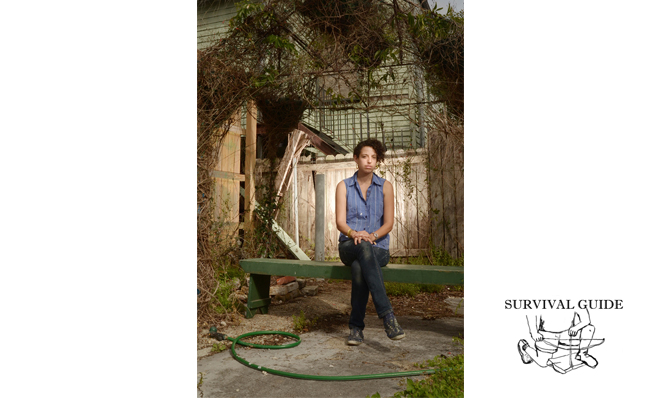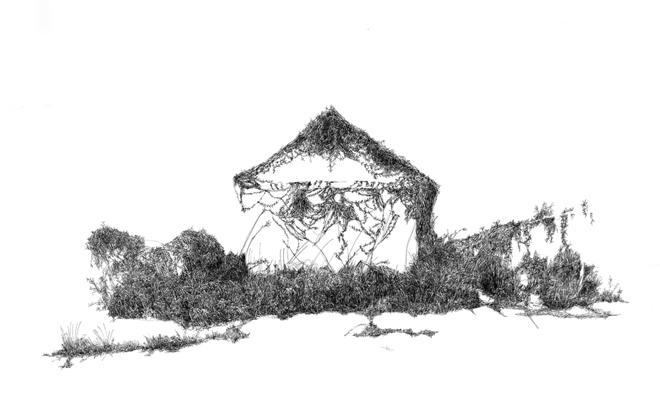Survival Guide: Hannah Chalew

If artist Hannah Chalew tenses up while working in the studio, she heads outdoors. Aubrey Edwards photographs Chalew outside her studio at T-Lot.
Survival Tip: “Make the work and something will happen.”
Editor's Note
Conceived by writer and artist Raina Benoit, the "Survival Guide" series asks artists in New Orleans how they are making their way in the city from studio spaces to exhibition opportunities, finding inspiration to day jobs. For the first in the series, Benoit interviews Hannah Chalew. Born and raised in New Orleans, Chalew takes on the city's post-Katrina landscape, exploring the nexus of architecture, nature, and everyday human life.
Raina Benoit: There's a great deal of talk today about the real value of MFA programs. You went to Brandeis University in Massachusetts, graduating with only a BA in 2009. What did you take away from the art program and how do you think you're applying it to your work today?
Hannah Chalew: I value that I got a liberal arts education and that it was well rounded. The visual arts department was so small that I could make it what I wanted. I don't know if the experience would have been as good if I hadn't had the background of my arts high school. I think the most I got out of the Brandeis program was being able to focus. I had my own studio and spent a lot of time in there.
RB: Your work’s subject matter is very specific, ornately depicting the blight growing on and within New Orleans architecture. There is a focus to your drawings rarely seen in such a young artist’s work. Where did you get your inspiration during undergrad and how did it grow into your current direction?
HC: I would take the bus to New York City for the day and go to the Metropolitan Museum, The Museum of Modern Art, or to the galleries in Chelsea. I also went to a program in upstate New York the summer between junior and senior year in 2008 at the Chautauqua School of Art. I think even more than Brandeis that’s what made me decide to become a professional artist. There, I studied landscape painting with Stanley Lewis. His insistence on being on site and being in the space was so influential, but it wasn’t until I did a residency at the Vermont Studio Center in 2010 that I realized how important New Orleans is to my work. I couldn’t just go outside and draw. I wasn’t struck by anything there. Someone said that I should draw this old fallen-down building they saw, but it didn’t grab me in the same way. So I’m starting to think about whether my art is specific to New Orleans. I hope it’s speaking to broader themes. Right now it’s rooted in the areas that I bike around and see every day. I actually have to survey the whole panorama around me at once rather than piece it together from photographs. For me, working outside means feeling that place and trying to translate this feeling into the drawing. The drawing becomes a record of my having been there and the people I met while within the space. I’m dealing with spaces that are devoid of people, but my work is all about people and the infrastructure of our society.
RB: What then is your relationship to the studio?
HC: I have a tendency to tense up in the studio. If I’m thinking, “What am I doing?,” then I’ll go outside and draw and that will give me more ideas. I always try to be out and about seeing the landscape. Whenever I’m moving through the city I’m always looking for viny growth. When people pass by and see me drawing, they always have something interesting to say. Either they didn’t notice the empty lot until they saw me drawing it or they thought the building taken over by vines was a nuisance. There’s always the person who wonders why I would be interested in this kind of subject. Their reactions and how they see these spaces is important to my process and the work.
RB: You share a studio space with four other artists at T-Lot. It’s categorized as a museum/art gallery on its Facebook page. Would you talk about why you began the space and the group’s goals for functioning as an artist-run gallery?
HC: We are really just a studio space now. We had two shows for Prospect.1.5 and Prospect.2. I do want to do future programming, but we need to make sure that all the studiomates are on board and can share the work load. When we first started T-Lot two years ago, our only exhibition space was our studios. Now that I’m represented by a gallery and invited to exhibit other places, I don’t need to turn my studio into a show space. But I’m still interested in utilizing T-Lot’s outdoor space for future shows. We happened to find a building with this amazing yard. We weren’t originally looking to have shows but the opportunity arose. For me and Stephen Kwok, who found the space, it was an important place for us to develop our work. I feel like it has been my postbaccalaureate.
RB: How do you divide up rent?
HC: We came up with a system based on the size of the studio. The whole space is $800.
RB: How do T-Lot artists support each other besides the shared financial responsibility?
HC: We are all very close friends. We just started a critique group, which I hope will be a monthly thing. Everyone really believes in each other. We are all in the same place —post college and pre grad school and everyone wants to be a professional artist.
RB: T-Lot has used creative fundraising such as Kickstarter for several group exhibitions. How successful was this for raising money and do you plan on using it for future exhibitions?
HC: Kickstarter was amazing. None of us are making money from the space. So the fundraised money helped us cover the expenses for the exhibitions. With the insistence of our landlord, these funds have also helped with liability insurance purchased from Fractured Atlas, which is a national service organization for artists.
RB: Do you think there are many opportunities for emerging artists in New Orleans?
HC: There are definitely many opportunities to show. I think there’s less opportunity to make money off your work. I feel really lucky to be getting onto this path with a commercial gallery. Jonathan Ferrara has a juried show every summer and he was really excited about the feedback to my work. He asked for a studio visit six months later and afterwards I invited him to one of my exhibitions. He saw a piece there that he really liked and then gave me a show.
RB: What has changed for you since showing at a commercial gallery?
HC: Any time I’m asked the price of my work, I get this weird feeling like I’m asking too much. But Jonathan Ferrara will say, “It’s $1500,” with no problem when I would have asked for something like $500. It’s hard to put numbers onto something you create.

Hannah Chalew, Devoid 1, 2012. Pen and ink on paper. Courtesy the artist and Jonathan Ferrara Gallery, New Orleans.



